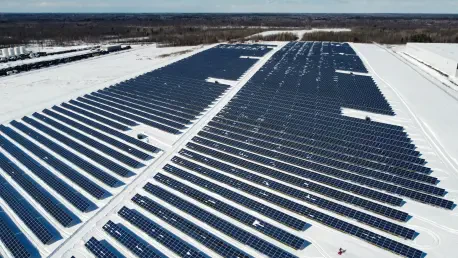Across the rolling landscapes of the United Kingdom, a silent crisis unfolds as bumblebee populations, crucial pollinators for ecosystems and agriculture, face alarming declines due to habitat loss, climate change, and intensive farming practices. These fuzzy insects, once a common sight in meadows and gardens, are now struggling to survive amidst shrinking natural spaces and erratic weather patterns. Yet, an unexpected ally may be emerging in the form of solar farms, sprawling installations designed to harness renewable energy. Recent research suggests that these sites, often seen solely as tools for combating carbon emissions, could double as sanctuaries for bumblebees if managed with biodiversity in mind. This intersection of clean energy and conservation presents a compelling opportunity to address two pressing global challenges simultaneously, sparking curiosity about whether such infrastructure can truly play a pivotal role in safeguarding these vital species.
Renewable Energy Meets Biodiversity
Solar Farms as Potential Havens
The concept of solar farms serving as wildlife refuges is gaining traction, particularly as the UK ramps up its renewable energy infrastructure to meet ambitious climate goals. A groundbreaking study from a leading scientific journal has explored how these vast arrays of panels could support bumblebee populations by providing much-needed foraging and nesting resources. The research, involving over 1,000 operational solar sites across Great Britain, utilized advanced modeling to simulate bumblebee behavior and population dynamics. Findings indicate that with intentional management, such as planting wildflowers around panels, bumblebee density within these areas could more than double compared to traditional turf-covered sites. This approach transforms otherwise underutilized land into a thriving habitat, offering a glimmer of hope for species battered by environmental pressures. The idea that energy production and nature conservation can coexist is not just innovative but also a practical step toward balancing human needs with ecological health.
Challenges of Scale and Impact
While the potential of solar farms to bolster bumblebee numbers is promising, their impact remains limited in scope against the broader backdrop of habitat fragmentation and systemic threats. The same study highlights that the positive effects are largely confined to the boundaries of the solar farms themselves, with little influence on surrounding landscapes shaped by intensive agriculture and urban sprawl. Bumblebee survival depends heavily on connectivity between habitats, and isolated patches of wildflowers, no matter how rich, cannot fully address the widespread loss of suitable environments. Researchers caution that without strategic siting to link fragmented areas, these sites risk becoming mere islands of refuge in a sea of inhospitable terrain. This reality underscores the need for a more integrated approach to land use, where renewable energy projects are planned with ecological corridors in mind to ensure lasting benefits for pollinators facing multiple stressors.
Conservation Strategies and Future Outlook
Integrating Solar Sites into Broader Networks
Turning solar farms into effective bumblebee sanctuaries requires more than just planting flowers; it demands a vision that connects these sites to wider conservation networks. Experts argue that strategic placement of solar installations near existing natural habitats or along migration routes could create vital stepping stones for bumblebees, enhancing their ability to forage and nest across larger areas. This connectivity is critical as projections suggest that many European bumblebee species could lose significant portions of suitable habitat in the coming decades due to climate shifts. By prioritizing locations that bridge gaps in fragmented landscapes, policymakers and developers can amplify the ecological value of solar farms. Collaboration between energy companies, conservationists, and local governments is essential to map out these opportunities, ensuring that renewable projects contribute meaningfully to biodiversity goals while powering homes and businesses with clean energy.
Balancing Energy Goals with Ecological Needs
As the UK continues to expand its solar capacity, striking a balance between energy production and ecological preservation emerges as a key challenge for the future. The dual potential of solar farms to generate low-carbon energy and support struggling species like bumblebees is undeniable, yet it requires careful planning to avoid unintended consequences, such as displacing other wildlife or disrupting local ecosystems. Thoughtful management practices, including diverse planting schemes and minimal pesticide use, can enhance the biodiversity benefits of these sites. Moreover, integrating lessons from pioneering studies into national policy could set a precedent for how renewable energy infrastructure is developed worldwide. Reflecting on past efforts, it’s clear that small-scale trials of habitat enhancement within solar farms have yielded encouraging boosts in local pollinator numbers, paving the way for scalable solutions that address both the urgency of climate action and the imperative to protect nature’s unsung heroes.









